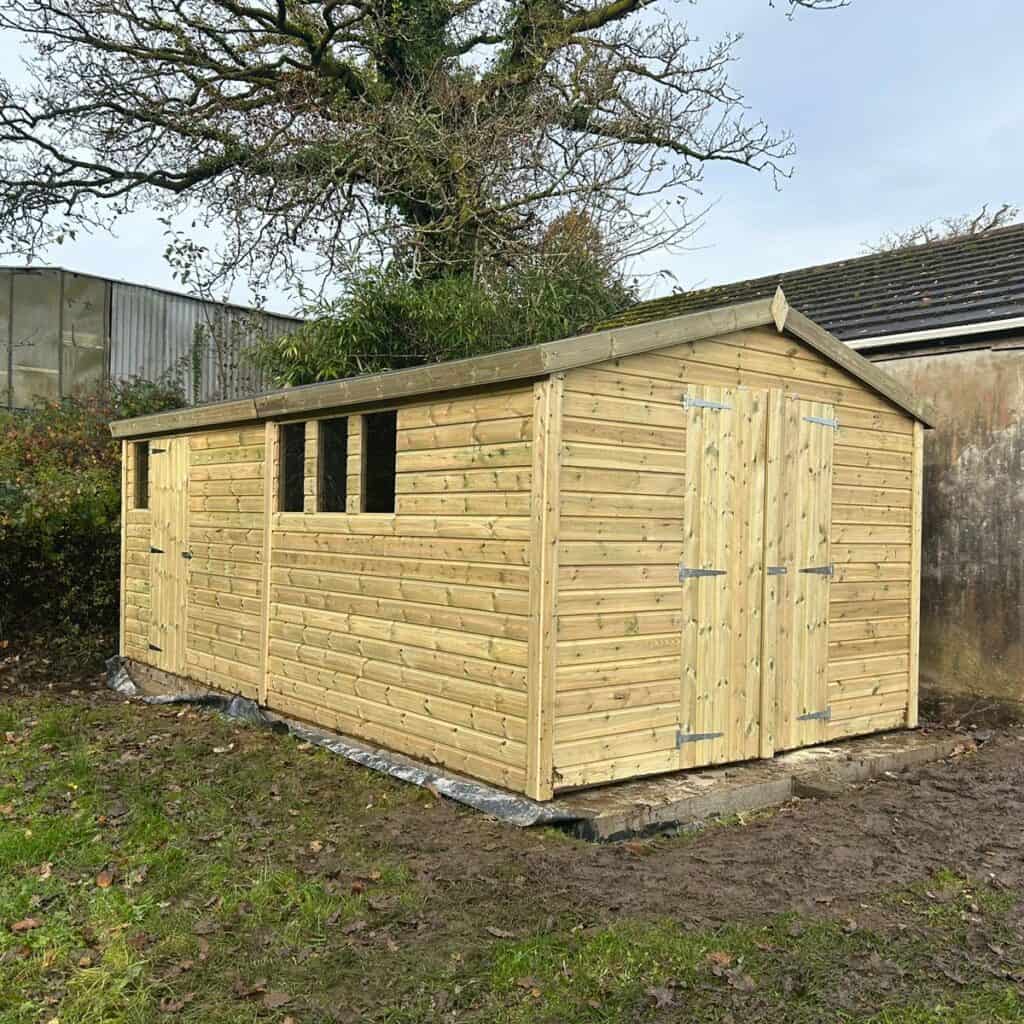Introduction
Wooden garden sheds are quintessential features in gardens across the globe, celebrated not only for their practicality but also for the aesthetic charm they add to outdoor spaces. These structures serve a myriad of purposes, from storing garden tools and equipment to providing a secluded retreat for hobbies or work. The allure of a wooden shed lies in its natural beauty, versatility, and the warmth it brings to the garden landscape.
The importance of having a wooden garden shed cannot be overstated. Beyond their primary function of storage, these sheds offer a unique space that can be tailored to an individual’s needs, whether it be a tranquil garden office, a cosy art studio, or a robust workshop. Their adaptability allows gardeners to not only organise and protect their gardening essentials but also to extend their living space into the outdoors.
Moreover, wooden garden sheds blend seamlessly with the natural environment, enhancing the overall aesthetic of a garden. Made from renewable resources, they are an eco-friendly option for those looking to minimise their carbon footprint. With various styles and sizes available, there is a wooden shed to suit every garden, no matter its size or the homeowner’s personal taste.
This guide aims to navigate you through the world of wooden garden sheds, covering everything from the different building styles and materials to their myriad uses and the essential preservation methods to keep them standing proudly for years to come. Whether you’re a seasoned gardener looking to upgrade your shed or a novice curious about the benefits, this ultimate guide will provide you with the knowledge and inspiration you need to make the most out of your garden shed. Join us as we explore the enduring appeal of wooden garden sheds and discover how they can transform your outdoor space into a more functional, beautiful extension of your home.
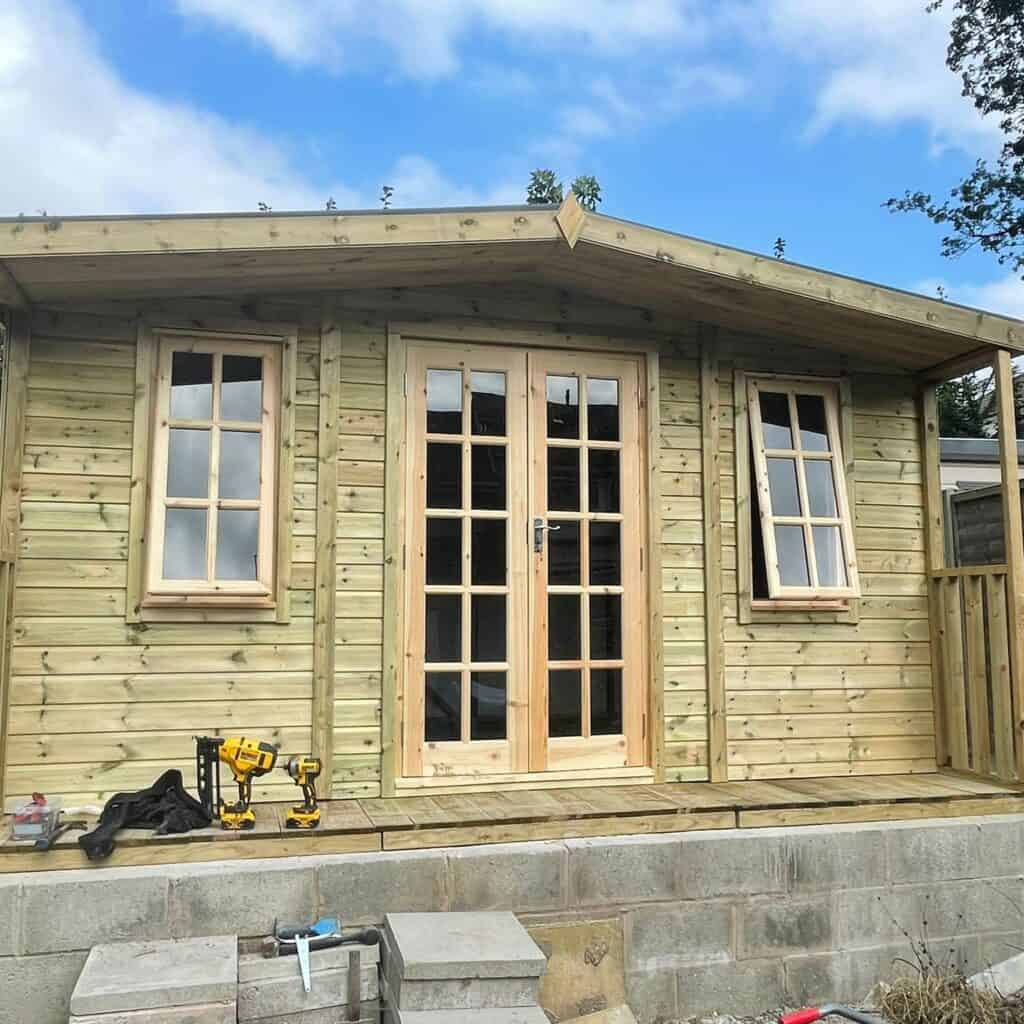
Types of Wooden Garden Sheds
The world of wooden garden sheds is diverse, with a variety of styles to accommodate different needs, preferences, and garden sizes. This chapter delves into the most popular types of wooden garden sheds, highlighting their features and benefits to help you choose the perfect shed for your garden.
Traditional Apex Sheds
The apex shed is the epitome of classic shed design, characterised by its triangular roof that peaks in the centre. This design not only offers a traditional aesthetic but also provides practical benefits such as increased headroom and effective water runoff, making it an ideal choice for regions prone to heavy rainfall. Apex sheds are versatile, suitable for a range of uses from storage to workshops, and are available in a variety of sizes to fit any garden space.
Pent Sheds
Pent sheds feature a single, sloping roof which typically runs from the front to the back of the shed. This design offers a modern, sleek look and is particularly well-suited to gardens with limited space. The sloping roof allows for water to drain off easily, reducing the risk of water damage. Pent sheds are perfect for storing garden tools and equipment, and their compact footprint makes them an excellent choice for smaller gardens or as secondary storage solutions.
Corner Sheds
Designed to fit snugly into the corner of a garden, corner sheds are an ingenious solution for maximising outdoor space. Their unique, five-sided design allows them to blend seamlessly into the garden, providing a practical storage option without sacrificing valuable lawn or patio space. Corner sheds are ideal for smaller gardens or for those looking to add storage without compromising on garden aesthetics.
Potting Sheds
Potting sheds are the gardener’s dream, designed specifically with gardening in mind. They often feature large windows and skylights to maximise natural light, creating an ideal environment for propagating plants and seedlings. Built-in workbenches and shelving provide ample space for gardening tools, pots, and accessories, making potting sheds a functional and highly organised space for green-fingered enthusiasts.
Workshop Sheds
For DIY enthusiasts and hobbyists, workshop sheds offer the perfect space to pursue projects and hobbies. Larger than your average garden shed, they provide ample room for workbenches, tools, and machinery. Workshop sheds are typically reinforced to support heavier items and may include additional features such as electrical outlets and insulation, making them a versatile and comfortable space for any project.
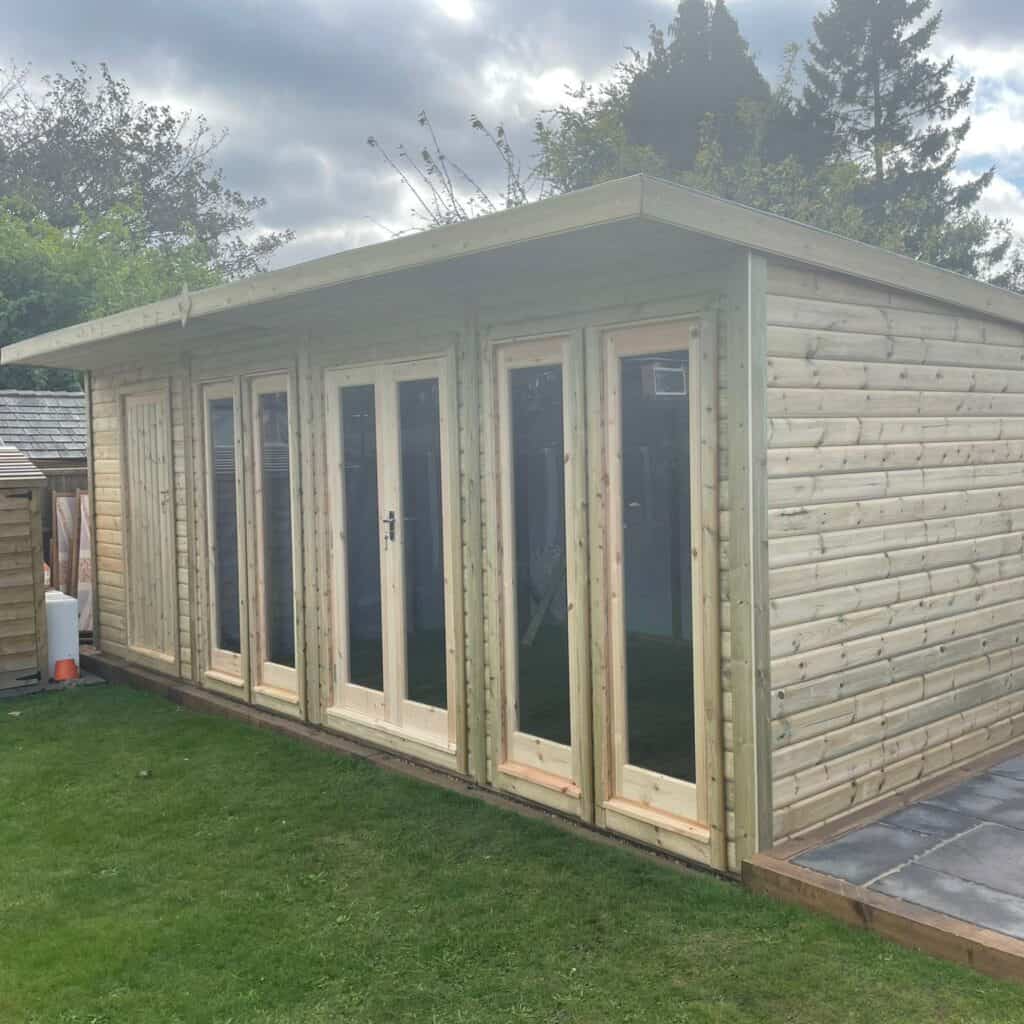
Choosing the Right Materials
Selecting the right materials for your wooden garden shed is crucial not only for its appearance but also for its durability and functionality. In this chapter, we’ll explore the types of wood, roofing materials, and flooring options that can be used to construct a garden shed, helping you make an informed choice that suits your needs and preferences.
Types of Wood for Sheds
Pine: Pine is a popular choice for garden sheds due to its affordability and availability. It’s a softwood that’s easy to work with, making it ideal for DIY projects. However, pine needs to be treated to protect it against rot, pests, and weather conditions.
Cedar: Cedar is renowned for its natural beauty and resistance to rot, pests, and decay, making it an excellent choice for garden sheds. Although it comes at a higher price point than pine, its durability and low maintenance requirements often justify the investment. Cedar also has a natural aroma that adds to its appeal.
Spruce: Spruce is another softwood option that’s more cost-effective than cedar but still offers decent durability when treated properly. It’s commonly used for shed construction due to its strength and relatively straight grain, making it a good option for those on a budget.
Roofing Materials
Felt Roofing: Felt roofing is one of the most traditional and economical choices for shed roofing. It provides a waterproof barrier that protects the shed from rain and snow. Regular maintenance is required to ensure its longevity, as it can be prone to tearing and deterioration over time.
Cedar Shingles: For those looking for a more aesthetic and durable roofing option, cedar shingles are an excellent choice. They not only enhance the shed’s appearance with their natural look but also offer long-lasting protection against the elements. Cedar shingles are more expensive than felt roofing but require less maintenance and can significantly extend the life of your shed.
Flooring Options
Concrete Foundations: A concrete foundation provides a stable and durable base for your garden shed. It’s particularly suitable for larger sheds or those that will house heavy equipment. Concrete is resistant to moisture, pests, and rot, ensuring your shed stays dry and secure. However, laying a concrete foundation requires more effort and expense than other flooring options.
Wooden Floors: A wooden floor is a popular choice for garden sheds due to its ease of installation and natural appearance. Treated timber can resist moisture and provide a sturdy base for your shed. Wooden floors are suitable for a variety of uses but may require more maintenance than concrete to keep them in good condition.
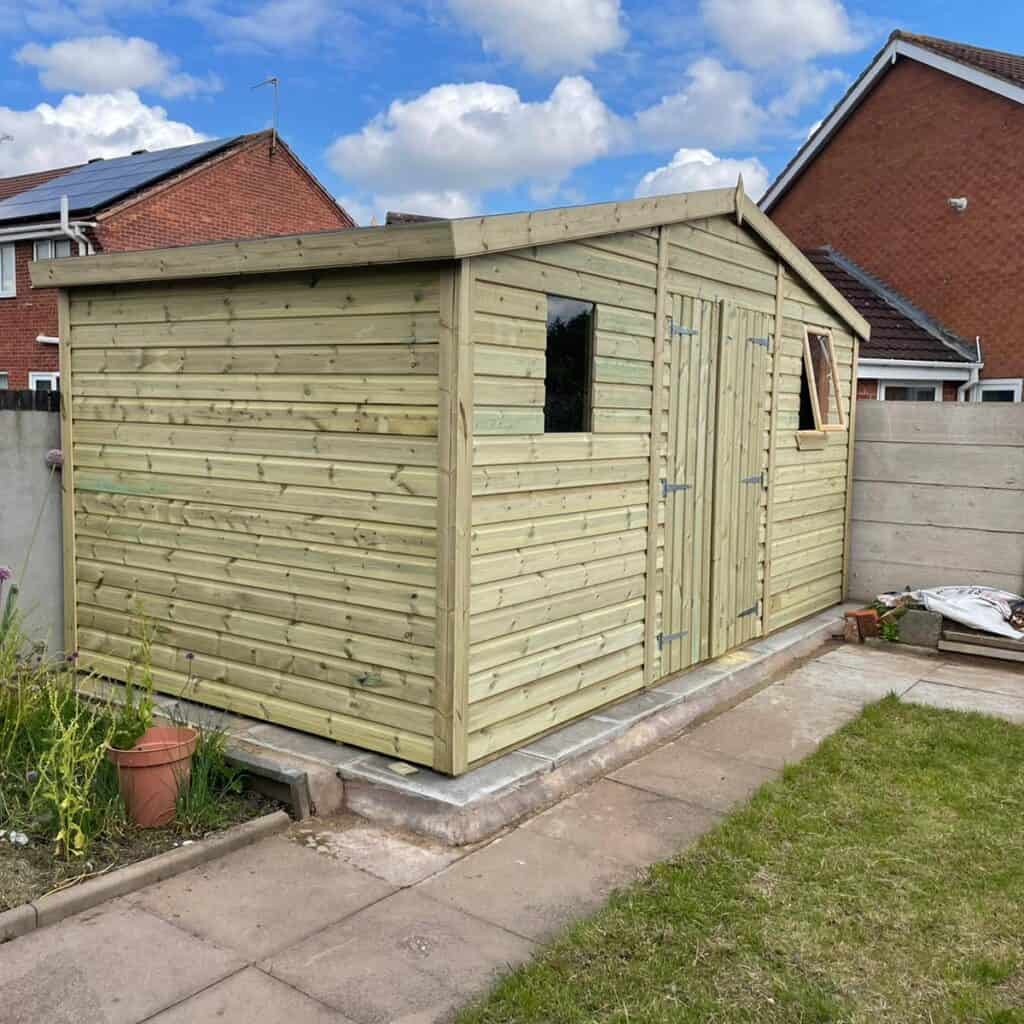
Making the Right Choice
When selecting materials for your wooden garden shed, consider the following factors:
- Climate: Choose materials that can withstand the weather conditions in your area, whether it’s heavy rain, snow, or high humidity.
- Purpose: Consider the intended use of your shed. For instance, a workshop may require a more durable floor, while a potting shed might benefit from cedar’s natural resistance to moisture.
- Maintenance: Think about how much time and effort you’re willing to invest in maintaining your shed. Some materials may require more frequent treatment or repairs than others.
- Budget: Balance your budget with your requirements for durability and appearance. Investing in higher-quality materials upfront can save money on maintenance and replacements in the long run.
Uses of Wooden Garden Sheds
Wooden garden sheds are versatile structures that can serve a wide array of functions beyond the traditional storage space. This chapter explores the various uses of wooden garden sheds, showcasing how they can be transformed to meet different needs and enhance your outdoor living experience.
Storage Solutions: Tools, Equipment, and Garden Supplies
The most common use of garden sheds is for storage. Wooden sheds offer a secure and organised space to store garden tools, lawn mowers, bicycles, and outdoor furniture during off-seasons. By incorporating shelves, hooks, and cabinets, you can maximise the storage capacity and keep your belongings easily accessible yet out of sight.
Hobby Room: Crafting, Painting, or Reading Space
A garden shed can be converted into a peaceful retreat for hobbies and crafts. With the addition of proper insulation, lighting, and comfortable furniture, your shed becomes the perfect spot for painting, crafting, or even reading. The tranquillity of being surrounded by nature makes it an ideal setting to ignite creativity and relax.
Home Office: A Quiet Workspace Away from the Main House
With more people working from home, converting a garden shed into a home office provides a quiet and separate space to concentrate and be productive. Equipped with a desk, chair, and internet connection, a shed office allows for a short commute to a peaceful work environment, free from the distractions of home life.
Gym: A Personal Fitness Centre
Transforming a wooden garden shed into a personal gym is a great way to stay fit without leaving your property. Installing gym equipment, mirrors, and proper flooring can turn your shed into a convenient and private space to work out at any time, saving you the cost and time of travelling to a commercial gym.
Playhouse: A Safe Play Area for Children
A wooden shed can be creatively adapted into a playhouse for children, offering a safe and imaginative play area in the comfort of your own garden. Decorated and furnished to cater to children’s fantasies, a playhouse shed can become a castle, a pirate ship, or a secret clubhouse, providing endless entertainment and a space for children to call their own.
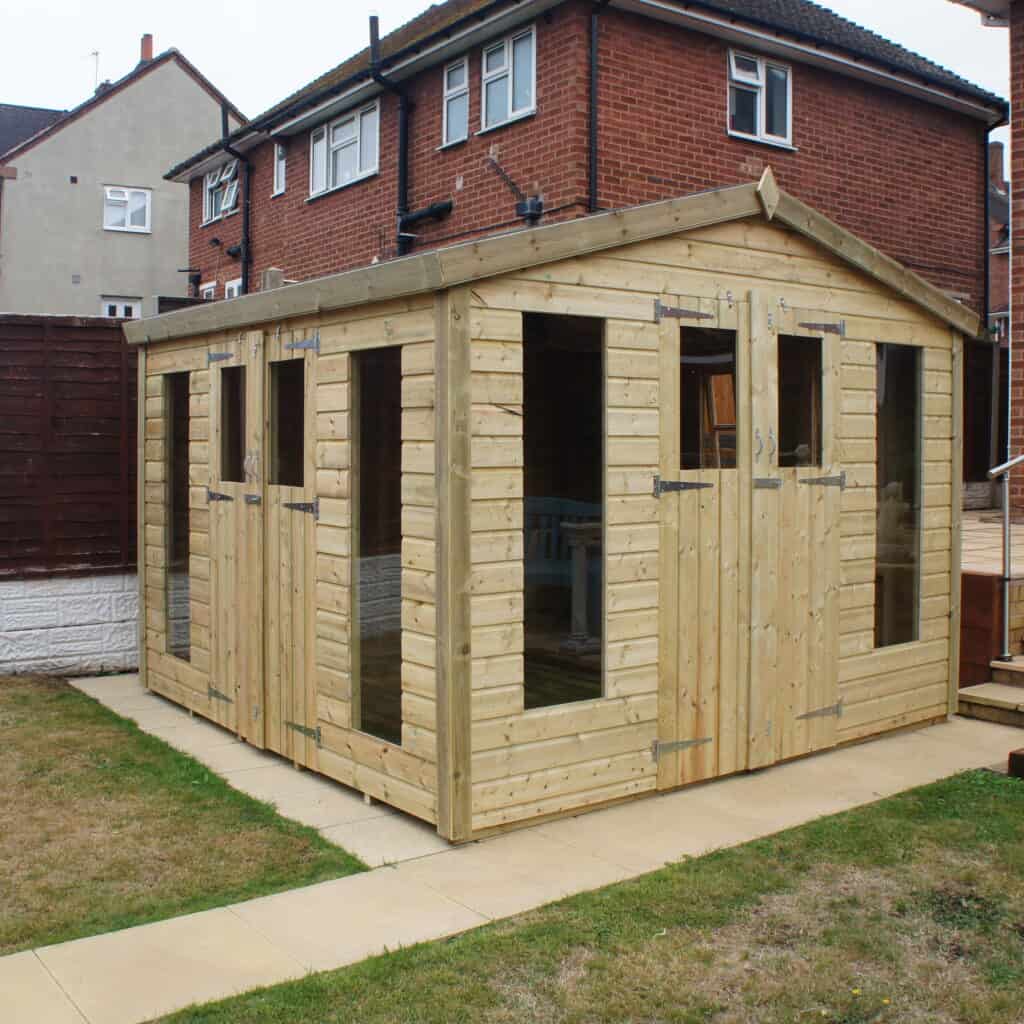
Enhancing Your Shed for Different Uses
To fully utilise a wooden garden shed for any of the above purposes, certain enhancements and modifications may be necessary:
- Insulation and Ventilation: Essential for creating a comfortable year-round space, especially for home offices, gyms, and hobby rooms.
- Lighting: Both natural and artificial lighting are important for functionality and ambiance, particularly for offices and hobby rooms.
- Electrical Outlets: Necessary for offices, gyms, and hobby rooms that require power for equipment, computers, or lighting.
- Decor and Furnishings: Personal touches transform a shed from a mere structure to a welcoming space tailored to your specific use.
Preservation and Maintenance
To ensure your wooden garden shed remains in excellent condition and serves its purpose for years to come, proper preservation and maintenance are crucial. This chapter provides a comprehensive guide to protecting your shed from the elements, pests, and general wear and tear.
Initial Treatment: Protecting New Wood
- Wood Preservative: Applying a high-quality wood preservative is the first step in protecting your shed from rot, mould, and insect damage. This should be done as soon as your shed is installed and before any paint or stain is applied. Focus on all surfaces, paying special attention to joints and end grains where moisture can easily penetrate.
- Choosing the Right Preservative: Opt for a preservative that offers UV protection to prevent the wood from greying and warping under the sun. Water-based preservatives are environmentally friendly and less toxic, making them a good choice for sheds used as playhouses or offices.
Regular Maintenance: Cleaning and Repainting
- Annual Inspections: Check your shed annually for signs of wear, including peeling paint, rotting wood, or loose roofing material. Early detection of these issues can prevent more significant problems down the line.
- Cleaning: Wash the exterior of your shed at least once a year to remove dirt, mildew, and algae. A mild soap solution and a soft brush are usually sufficient for this task.
- Repainting or Restaining: Depending on the finish, your shed will need to be repainted or restained every few years to maintain its appearance and protective layer. Always clean and sand the surface before applying a new coat to ensure it adheres properly.
Pest Control: Preventing and Managing Infestations
- Regular Checks: Look out for signs of pest infestations, such as chewed wood, droppings, or nests. Common shed pests include termites, mice, and wasps.
- Sealing Gaps: Ensure your shed is well-sealed to prevent pests from entering. Fill gaps around doors, windows, and the base of the shed with suitable materials.
- Natural Repellents: Consider using natural repellents like cedarwood chips or essential oils to deter pests without resorting to harsh chemicals.
Weatherproofing: Ensuring Durability Against the Elements
- Roof Maintenance: Keep the roof in good condition by replacing worn or damaged roofing felt or shingles promptly. Ensure that gutters and downspouts are clear of debris to prevent water damage.
- Proper Ventilation: Good ventilation helps to prevent condensation inside the shed, reducing the risk of dampness and rot. Ensure your shed has vents or windows that can be opened to allow air circulation.
Repairing Damage: Tips for Fixing Common Issues
- Rotting Wood: Replace any rotting timbers as soon as possible to prevent the spread of decay. Use treated wood for any replacements to enhance durability.
- Loose Hinges or Handles: Tighten or replace loose hinges and handles on doors and windows to improve security and prevent drafts.
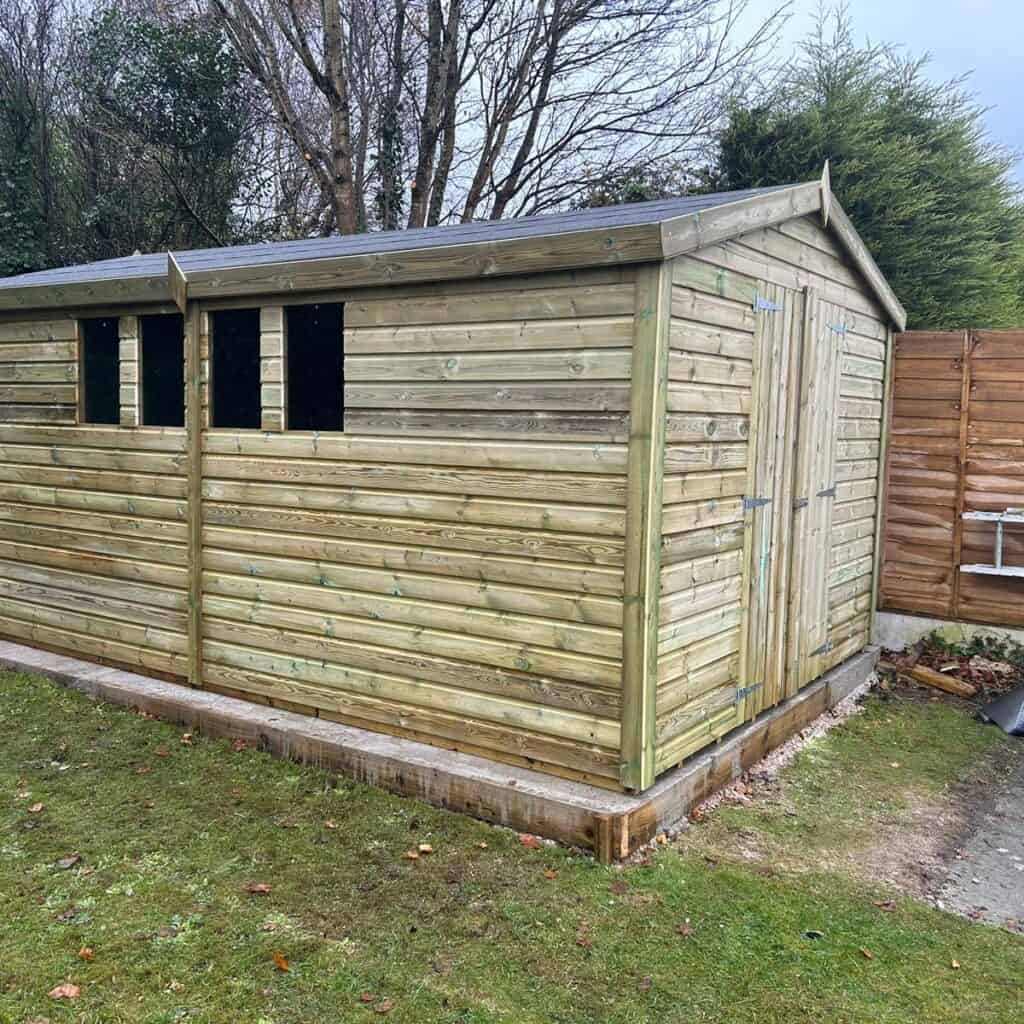
Customisation and Decoration
Transforming a wooden garden shed from a simple structure into a personalised and inviting space adds immense value and enjoyment to your garden. This chapter explores how to customise and decorate your shed, tailoring it to your tastes and needs, making it not just a functional space but also a reflection of your personality and creativity.
Personalising Your Shed: Paints and Finishes
- Choosing Colours: Selecting the right colours can dramatically change the appearance of your shed. Consider using shades that complement your garden’s theme or the exterior of your home. Light colours can make the shed feel larger and blend with the surroundings, while bold colours can turn it into a striking garden feature.
- Finishes: Whether you opt for a natural wood finish that highlights the beauty of the grain or a painted finish for protection and style, the choice of finish can significantly impact the maintenance requirements and the shed’s longevity. High-quality exterior paint or stain can protect the wood from the elements and reduce the need for frequent upkeep.
Adding Windows and Skylights: Enhancing Natural Light
- Windows: Adding windows not only improves the aesthetic appeal of your shed but also increases natural light, making the interior more welcoming and usable for activities that require good visibility. Consider the direction of light when positioning windows to maximise sunlight at the right times of day.
- Skylights: For sheds used as workspaces or hobby rooms, skylights can provide additional light and ventilation, creating a brighter and airier space. They are particularly beneficial in smaller sheds where wall space for windows might be limited.
Landscaping Around Your Shed: Gardens and Pathways
- Garden Beds: Surrounding your shed with garden beds filled with flowers, shrubs, or herbs can integrate it seamlessly into the garden, enhancing its charm. Choose plants that match the shed’s style and colour for a cohesive look.
- Pathways: Creating a pathway to your shed with paving stones, gravel, or stepping-stones not only provides practical access but also adds to the overall garden design. Pathways can lead the eye to the shed, making it a focal point of your outdoor space.
Interior Design: Maximising Space and Functionality
- Furniture and Storage: Tailor the interior to your shed’s purpose with appropriate furniture and storage solutions. Fold-down workbenches, built-in shelving, and hooks can maximise space in a workshop, while comfortable seating and ambient lighting can turn a shed into a cosy retreat.
- Decor: Personal touches like rugs, curtains, and artwork can transform the interior of your shed, making it feel homely and inviting. Consider the shed’s use and your personal style when choosing decor to create a space that feels uniquely yours.
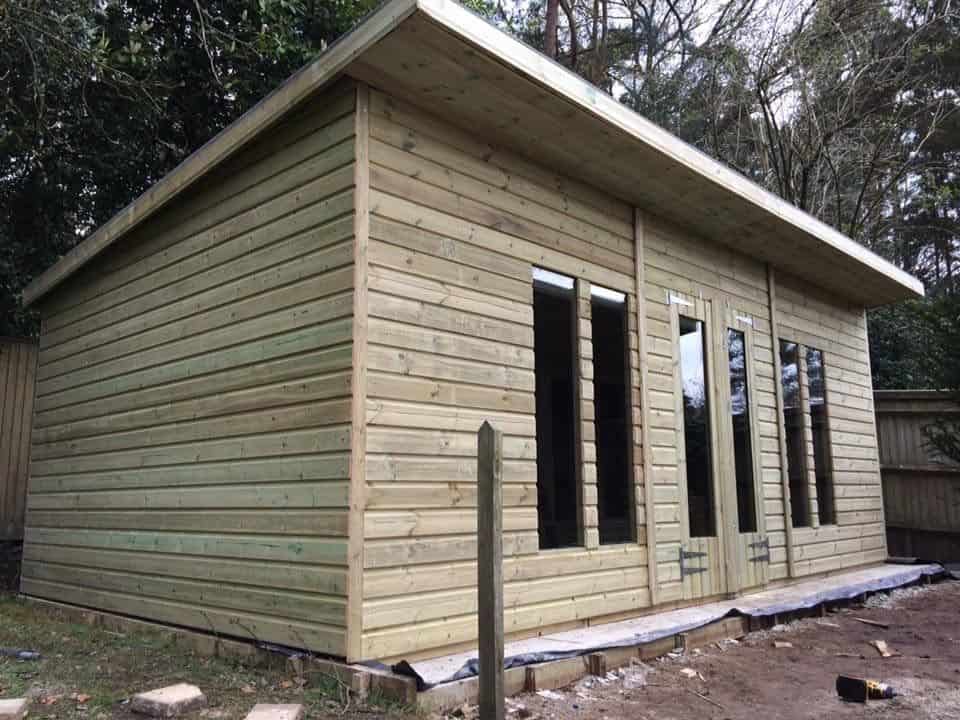
Planning and Building Your Shed
Constructing a wooden garden shed is a rewarding project that can enhance your outdoor space and provide valuable storage or workspace. This chapter guides you through the planning and building process, from navigating legal requirements to laying the foundation and assembling the shed.
Legal Considerations: Permits and Regulations
Before embarking on building your garden shed, it’s crucial to understand the legal requirements:
- Permits: Check with your local council or building authority to determine if you need a permit for your shed. Requirements can vary based on size, location, and intended use.
- Building Regulations: Familiarise yourself with any building regulations that may apply, such as those relating to structural integrity, fire safety, and distance from property boundaries. Adhering to these regulations ensures your shed is safe and legal.
Site Preparation: Choosing a Location and Preparing the Ground
Selecting the right location for your shed and preparing the site is foundational to your project’s success:
- Choosing a Location: Consider factors like sunlight, accessibility, and drainage when selecting a site for your shed. Avoid areas prone to flooding or excessive shade.
- Ground Preparation: The ground should be level and firm. Remove any vegetation, rocks, or debris. For larger sheds or those on uneven ground, you may need to excavate and lay a more substantial foundation.
DIY vs Professional Installation: Weighing the Pros and Cons
Deciding whether to build the shed yourself or hire professionals depends on various factors:
- DIY Benefits: Building the shed yourself can be more cost-effective and offers a sense of accomplishment. It allows for complete customisation and flexibility in the construction process.
- Professional Installation Advantages: Hiring professionals can save time and ensure the shed is constructed correctly and efficiently. It’s particularly beneficial for those with limited DIY experience or for more complex projects.
Step-by-Step Building Guide: From Foundation to Finishing Touches
- Foundation: Whether you choose a concrete slab, paving slabs, or a wooden base, ensure the foundation is solid, level, and appropriate for the size and weight of your shed.
- Framing: Erect the frame of the shed, starting with the floor, followed by the walls, and then the roof structure. Ensure everything is square, level, and securely fastened.
- Roofing: Install the roofing material, whether it’s felt, shingles, or another option, making sure it’s watertight and properly secured.
- Cladding and Windows: Attach the wall cladding, starting from the bottom and working up. Install any windows or doors, ensuring they are correctly aligned and operate smoothly.
- Finishing Touches: Apply a preservative or paint to protect the wood and enhance the shed’s appearance. Add any interior fixtures or fittings, such as shelving, benches, or lighting, according to your needs.

Conclusion
Throughout this ultimate guide to wooden garden sheds, we have journeyed from understanding the varied types of sheds and the importance of selecting the right materials, to exploring the multitude of uses these versatile structures can offer. We delved into the essential preservation techniques that ensure longevity and concluded with inspiring ideas on how to personalise and truly make a shed your own.
Wooden garden sheds are more than just places for storing tools and garden equipment; they are potential havens for creativity, productivity, and relaxation. The beauty of these structures lies in their versatility and the personal touch each owner can add, transforming them into unique spaces that reflect individual needs and styles. Whether it’s a cozy retreat, a bustling workshop, or a well-organised storage area, a wooden shed can significantly enhance your outdoor living experience.
The key to a shed that stands the test of time lies in thoughtful planning, regular maintenance, and a bit of creativity. Choosing the right materials and following through with proper care will protect your investment and ensure that your shed remains a valuable and functional part of your garden for years to come. Moreover, customising your shed to suit your lifestyle not only maximises its usefulness but also turns it into a source of joy and pride.
In embarking on the shed-building journey, remember that the process itself can be as rewarding as the end result. From the initial design choices to the final touches of decor, each step offers an opportunity to learn and create something truly special.
We hope this guide has provided you with the knowledge, inspiration, and confidence to create a wooden garden shed that meets your needs, complements your outdoor space, and becomes a cherished addition to your home. Let your garden shed be a testament to your creativity, a space where functionality meets beauty, and a reflection of your personal connection to your garden.

